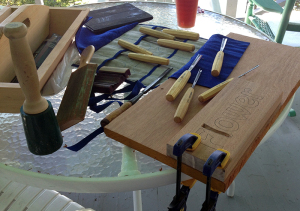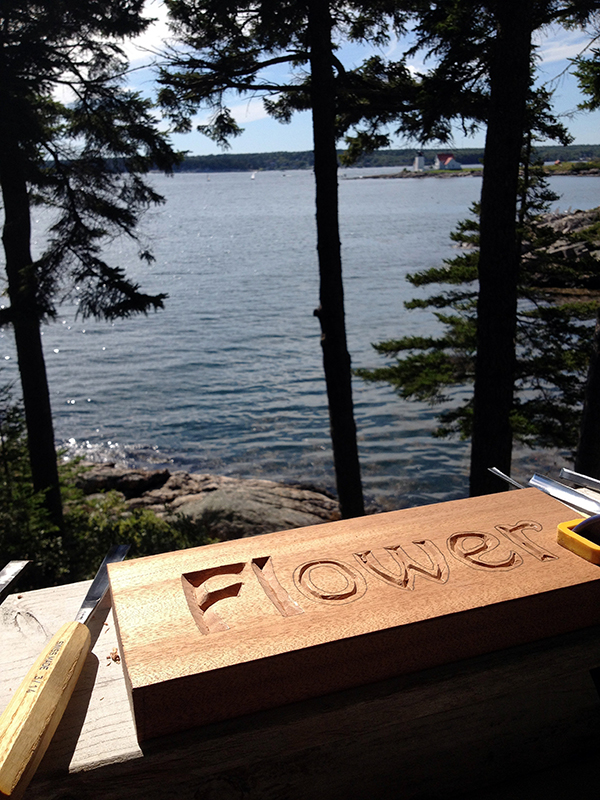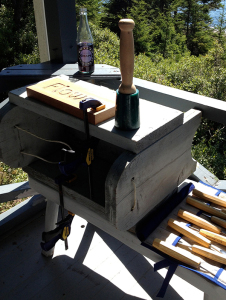We Don’t Need No Stinking Workbench
For my Hand Tool School members, my views on workbenches are probably burned into their consciousness as I have spouted them innumerable times. For you remaining (and unlucky) few, my views may not be as well known. I do NOT advocate making a workbench right away as a first project. There are just so many variables yet to discover about how one works wood that can influence the design of a workbench. Work holding, size, and the ever controversial workbench height elements all need to be considered and matched to the type of work you enjoy doing. If you haven’t done a lot of work yet then how can you know what elements will suit your style. Certainly one can hypothesize and build to the theoretical future self. There is also merit to the supposition that a workbench makes a good project on which to cut one’s teeth with certain techniques. I can’t deny this but I maintain that you can spend a heck of a lot less money and time by building skills making small projects like boxes, try squares, bench hooks, and saw benches. I’ll back away from this statement a little more and say that the Roubo and Nicholson style benches provide a really solid “chassis” that can be augmented easily to incorporate new elements as you discover your working style. One could make a case for saying that with a blank slate style chassis, the bench will adapt easily to your work. So I’ll grant some wiggle room on this subject because of the renaissance in bench design we have seen in the last decade.
The inevitable retort I receive when I spout this opinion (while standing in front of my own Roubo workbench) is,
“That’s fine for you to say, you already have a bench!”
This is the same as the guy telling you that flattening a board by hand is easy as pie when you can clearly see a power jointer and planer in the background. (been there done that, sold them all just to stop the hate mail) My point to all this is not to discourage people from building a workbench. If that’s what you really want to do, go for it. Just don’t let a lack of workbench hold you back from working in the first place. I can’t count the number of comments I have heard/read that start with some variation of “as soon as my bench is finished, I’ll…”.
Grab a door or slap together some plywood or home center 2×4 and get to work. You will learn volumes about what you want in a workbench by actually working wood. You will be surprised just how much a workbench isn’t necessary. In fact, once you have fought through workbench inadequacies and determined where you need a vise or dog hole or more weight you will build a bench that you can appreciate even more. It is like my T-ball coach used to say, “suck it up you wimps, pain builds character!”
 Last week when I was in Maine all of this was perfectly illustrated when I was tasked by my mother-in-law to carve some house signs for their new place. There was not a workbench to be found anywhere on the property nor was there room in our car for me to bring my mobile workbench/toolbox with us. I’m still wondering what my wife put in all those suitcases! With no other option, I sat down at the glass topped patio table and clamped the project piece to the top with some quick clamps and went to work. One letter in and I realized that while the board was firmly clamped to the table top, the table itself had quite a bit of flex to it. Every cut with a gouge was spilling the applied force into flexing the table before it started cutting wood. This was made worse when I pulled out a mallet to use with my V tool. Secondly, I had to sit down at the table and I never like sitting and carving because I move around too much when working with the grain. Lesson learned. I needed something more solid, that allowed me to stand.
Last week when I was in Maine all of this was perfectly illustrated when I was tasked by my mother-in-law to carve some house signs for their new place. There was not a workbench to be found anywhere on the property nor was there room in our car for me to bring my mobile workbench/toolbox with us. I’m still wondering what my wife put in all those suitcases! With no other option, I sat down at the glass topped patio table and clamped the project piece to the top with some quick clamps and went to work. One letter in and I realized that while the board was firmly clamped to the table top, the table itself had quite a bit of flex to it. Every cut with a gouge was spilling the applied force into flexing the table before it started cutting wood. This was made worse when I pulled out a mallet to use with my V tool. Secondly, I had to sit down at the table and I never like sitting and carving because I move around too much when working with the grain. Lesson learned. I needed something more solid, that allowed me to stand.
Some aimless wandering around the outside of the house produced a sitting bench made from a log and a flower planter that wasn’t being used made from nailed together 2x construction lumber. I clamped those on top of each other and went back to work. Now there was no flex and I could stand at my “bench”. However I was stooping quite a bit and the assembly was able to rock and move around the floor whenever I exerted force tangentially to the work surface. Next lesson learned: more height and some way to stabilize the bench were in order.
I grabbed another planter box and clamped that on top of the last one thereby adding 10 more inches in height and bringing the work surface up to waist height. This was a little lower than I like at home on my Joinery Bench but still a comfortable working height. Of course with more height the whole assembly became a little tippy. Now I moved my bench over to the corner of the deck so that every thing was pressed up against the railing and into the corner 4×4 roof post. Now my bench essentially weighed the same as the entire house and would not move in the slightest. And that is how I worked for the next few days.
It wasn’t pretty at all and I had to make a few compromises but I was allowed to get on with my carving and learned just how little I really needed in a workbench for that task. Other than the height issue, I can think of no shortcomings from this set up to what I have back in my own shop with two glamorous workbenches. In fact, this vacation workbench came with something my benches at home don’t have: sunshine and a breathtaking view.
Maybe I’ll invest in a landscape photo back drop for my workshop in the garage to see if I can retake my workbench with a view.




